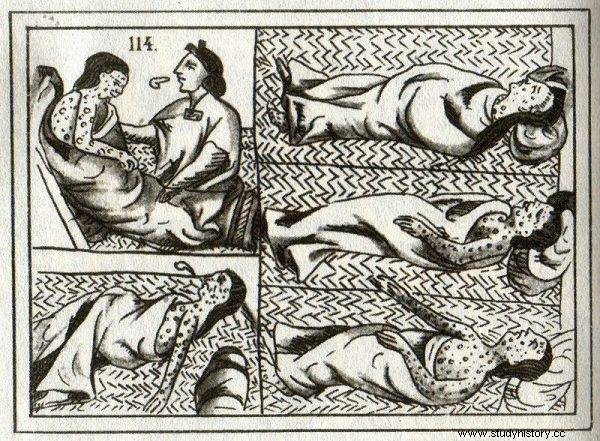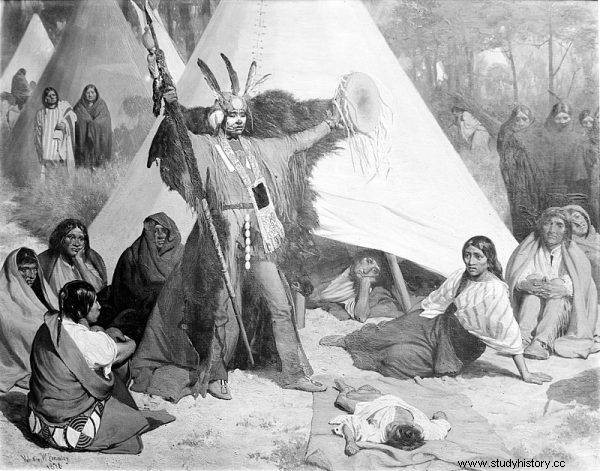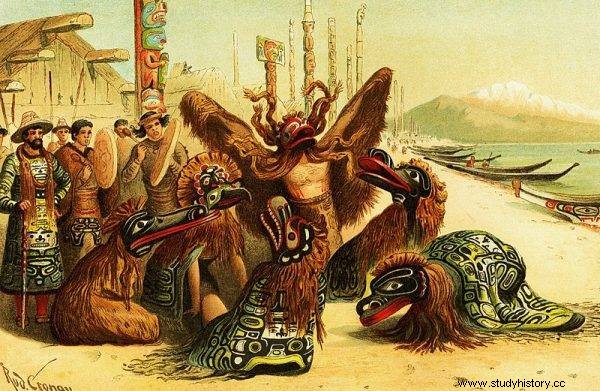The discovery of America was a tragedy for its indigenous peoples. Indian civilizations almost died out. The survivors lived in a post-apocalyptic world.
We should start by thinking - was it really that bad? Did the vast majority of Native Americans actually die? And did it have anything to do with the arrival of Europeans? The answer to these questions is definitely yes. Of course, if you delve into the details, it's not that simple anymore. First, it is difficult to quantify the population of the New World before 1492. After all, no one was keeping censuses at that time. Estimates based on what is known from the colonial period range from 40 to 112 million. Most hover around 60 million, which means a population slightly smaller than that of Europe at that time. You should also remember that the Americas had very densely populated areas (such as Central Mexico) and almost uninhabited (such as northern Canada).
How many Native Americans died?
Another problem is the population estimation already in the colonial period. In Central Mexico or Peru, where the Spaniards settled down fairly quickly and started collecting taxes, the data is much more specific. However, still inaccessible areas, such as the Amazon, remain. In this case, researchers have to make estimates based, for example, on archaeological sources.

How was this related to the arrival of Europeans in the New World? Together with them, European germs such as smallpox, measles, flu, plague, malaria, diphtheria, typhus and cholera traveled overseas.
Anyway - the population of the New World around 1600 is estimated at 4.5 to 14.4 million. Usually numbers closer to this lower value are reported. This means that in just over a hundred years the population has shrunk by around 90%, and in some regions up to 95% . In a word:it was a real apocalypse. The Black Death epidemic in Europe had a lower death rate! Yet many historians consider it a turning point in the history of the Old Continent.
Read also:Slavery and bloody conquest in the name of God, or what Columbus brought to America
Everyone gets sick, most dies
How was this related to the arrival of Europeans in the New World? European germs, such as smallpox, measles, flu, plague, malaria, diphtheria, typhus and cholera, arrived overseas . Native Americans have never had a chance to encounter these pathogens. Their immunity was zero. As a result, each epidemic was much more devastating than in Europe .
When a virus or bacterium started spreading among the local community, everyone started getting sick almost simultaneously. For this reason, the most suffering could not count on any help. Actually, no one could count on any help . Many died only because there was no one to prepare food or give them water.

When a virus or bacterium started spreading among the local community, they all started getting sick almost simultaneously.
The dead weren't buried because there was simply no one to handle it. The decaying corpse made the situation even worse. Traditional treatments didn't work. Inventions, such as quarantine, that could help a little, were not known. It even happened that panic broke out in some places. The population fled and the epidemic spread even further.
Hunger Outbreak
The end of the plague did not necessarily improve the situation. Mortality rates of up to 50% meant that there was not enough man to work. As a result, there was no one to harvest or (depending on the season) sow or plant plants. Even if the mortality rate was lower, many convalescents required convalescence and were unable to perform heavy agricultural work. This, of course, resulted in hunger and more deaths. The hunger was followed by weakness and susceptibility to further diseases. Over and over again.
This is how the situation in Brazil in 1563 was described by a direct witness of these events, Jesuit Leonardo do Vale:
When the anguish was over and they wanted to raise their heads a little, they got another illness, much worse than the last . It was a kind of smallpox so disgusting and foul that no one could withstand the enormous stench they smelled from [the sick]. For this reason many died unattended, eaten by worms that grew in the smallpox wounds and multiplied in their bodies in such abundance and size that they terrified and terrified anyone who saw them.
Read also:Four Epidemics That Changed History
End of Civilization
One plague was a disaster. The whole century of successive epidemics was tantamount to the disintegration of social ties, the disappearance of culture and the collapse of the institutions of power . The rulers, aristocrats, shamans, warriors, farmers and craftsmen were dying. Those who somehow survived were not able to live as before.

Even if the Europeans didn't get there, the germs didn't have a problem with that.
Even if the Europeans didn't get there, the germs didn't have a problem with it. Take, for example, the southeast of the modern United States. Around 1700, tribes such as the Krikowie, Cherokee, Czoktawowie and Szaunsie lived there. Very interesting communities, no doubt. However, they were characterized by little social stratification, simplicity of political organization, and an economy partly based on gathering and hunting. All these peoples were heirs of the Mississippi culture, which built gigantic earth mounds, grew maize on a large scale, had clear social stratification and a complex political organization. By a strange coincidence, its collapse coincided with the beginning of the European exploration of these areas .
The most likely explanation for the end of this extremely interesting civilization are successive epidemics. The few who survived had to live a simple life in small communities. And that's just one example of many.
Read also:Truth or myth? Several hundred conquistadors conquered the Indian empires
Bad End
Epidemics have been a major, though not the only, cause of the decline in the New World population. The effects of brutal conquests by European colonial powers and the exploitation or even taking the natives captive . Different parts of the Americas experienced these terrible tragedies at different times. While the indigenous populations were slowly recovering in Mexico in the 18th century, the worst was yet to come in the United Kingdom-controlled areas.
Quite often you can hear the opinion that even if European colonization caused great suffering to the people of Mexico, they still did well. After all, the Spaniards freed them from the Aztec terror. However, there could be no terror, because the Aztecs, their rituals and beliefs were nothing strange in this part of the world. In addition, the number of human casualties across central Mexico is estimated at around 20,000 annually . Was it really the more favorable scenario for depopulation of 90%?
References:
- Alfred W. Crosby, Imperialismo ecológico, La expansión biológica de Europa, 900-1900 , Editorial Critica, Barcelona 1999.
- Alfred W. Crosby, Virgin Soil Epidemics as a Factor in the Aboriginal Depopulation in America , "The William and Mary Quarterly," vol. 33, April 1976, pp. 289-299.
- David E. Stannard, American Holocaust. The Conquest of the New World , Oxford University Press, New York, Oxford 1992.
- John Hemming, Red Gold. The Conquest of the Brazilian Indians , Harvard University Press, Cambridge 1978.
- Alexander Koch, Chris Brierley, Mark M. Maslina, Simon L. Lewis, Earth system impacts of the European arrival and Great Dying in the Americas after 1492 , "Quaternary Science Reviews" vol. 207, March 2019, pp. 13-36.
- Robert McCaa, ¿Fue el siglo XVI una catástrofe demográfica para México? Una respuesta basada en la demografía histórica no cuantitativa, Robert McCaa, "Cuadernos de Historia", vol. 15 December 1995, pp. 123-136.
